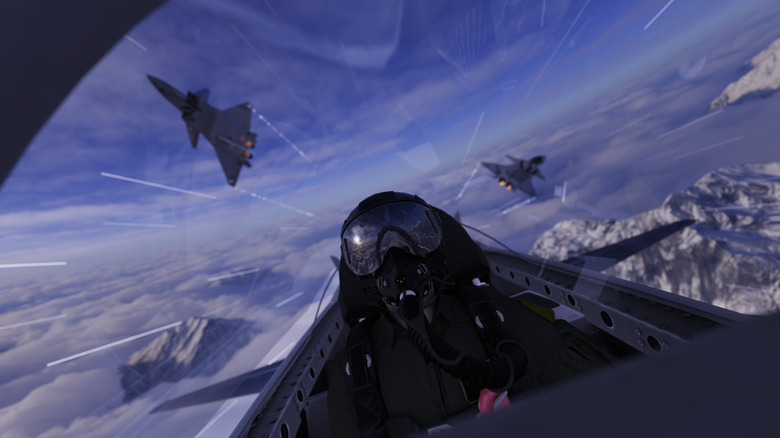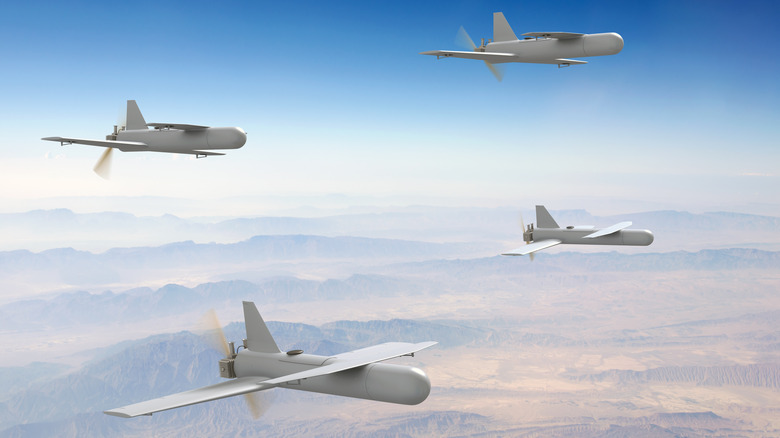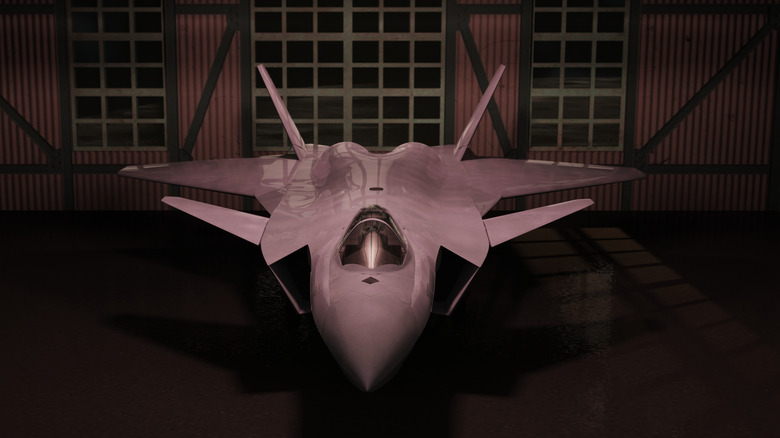China Is Developing A Transforming Stealth Fighter Jet: Here's What We Know About It
The People's Republic of China has long been interested in refining its weapon systems and aircraft, and the nation is pushing boundaries in terms of innovative engineering. In May 2024, news broke in the Chinese journal "Advances in Aeronautical Science and Engineering" that the China Aerodynamics Research and Development Centre (CARDC) successfully tested a new stealth fighter, and it's unusual, to say the least.
The new aircraft, which currently has no designation or photographs of what it might look like, is apparently more than meets the eye. The new fighter isn't merely a stealth aircraft — it's reportedly a drone mothership. During its test flight, the aircraft is said to have separated its wings to unleash two drones in the shape of a flying wing. Each drone is said to be independently powered by electric ducted fans. During the test flight, the drone separation maneuver reportedly caused flight instability due to the aerodynamic shift, but the aircraft and its drones remained airborne.
This is a significant leap in development, not only for stealth fighter aircraft but also for drone technology. The ability to deploy drones from a fighter adds an entirely new level of complexity to aerial warfare, and the possibilities of what the drones may provide are almost endless. Senior engineer from the Aerospace Technology Institute at CARDC, Du Xin, emphasized how the drone integration enables coordinated operations between the jet and its drones, indicating the aircraft will function in tandem while supporting one another on a mission.
Why add drones to a fighter?
A fifth-generation stealth fighter is, in and of itself, a remarkable piece of engineering technology. The same is true of modern UAVs, but integrating them into an airframe capable of transforming and unleashing drones could significantly increase all three aircraft's lethality. Du said, according to the South China Morning Star, "This can effectively address issues such as speed mismatch and range incompatibility between manned and unmanned aircraft, achieving complementary advantages."
What's so impressive about this new approach to drone and fighter warfare is that China is alone in its development. The U.S. has multiple drone-launch capabilities, but doing so from a fighter isn't an option. The U.S. Air Force is interested in deploying drone swarms, like the one pictured, from KC-135 tanker aircraft, which are predominantly used for refueling. If the U.S. has a similar concept for a transforming fighter, it's keeping that information from the public, and China's revelation of its new fighter-integrated-drone technology suggests it's further along than the American KC-135 plan.
Regarding how this all works, the paper published in the journal states, "The main aircraft connects to the leading edges of two sub-aircraft wings via a retractable separation mechanism at the main wing's trailing edge." The test flight indicates the possibility of further development, though issues related to a shifting center of gravity upon deployment remain. It's also unclear if the drones will be recoverable, or if they will be released in a "fire and forget" capacity to support the operation in which they're tasked.
What the future holds
The PRC takes its time developing its weapon systems, so it's unlikely a new jet will be unleashed upon the world anytime soon. Presently, China already has the J-20 Mighty Dragon, pictured above, in its arsenal, and it's comparable to the American F-22, so there's already a close parity between the two nations. Adding new functionality could propel China beyond current American military technology. China is also developing its first strategic bomber, so this innovation indicates the PRC's interest in continuing that trend.
While the J-20 won't operate like the fighter tested with this new technology, Du suggests future models will. "Future aircraft may be like the Transformers in science fiction movies. In the near future, we will soon see the J-30 and J-40." China's interest in furthering its drone technology has been ongoing for several years. In March 2024, China unveiled a new type of drone capable of splitting into six separate vehicles to overwhelm an enemy's defenses.
It's unclear what China might use fighter-launched drones for, but there are many possibilities. Drones could be used as anti-missile deterrents, they could provide "eyes in the sky" for situational awareness, they can be used as attack aircraft, and many other things — there are truly a plethora of possibilities. Should China finalize its design and add this new fighter to its inventory, there's no telling how they will be used in and out of combat, but it's something analysts in the West should be watching.


